Related Research Articles
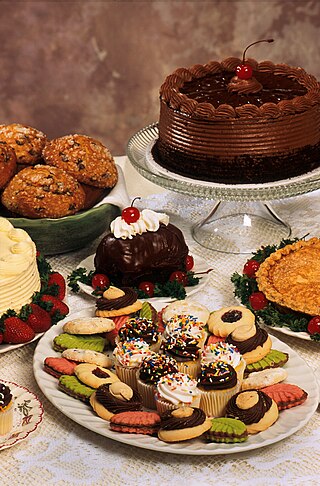
Dessert is a course that concludes a meal. The course consists of sweet foods, such as cake, biscuit, ice cream and possibly a beverage such as dessert wine and liqueur. Some cultures sweeten foods that are more commonly savory to create desserts. In some parts of the world there is no tradition of a dessert course to conclude a meal.

Confectionery is the art of making confections, or sweet foods. Confections are items that are rich in sugar and carbohydrates although exact definitions are difficult. In general, however, confections are divided into two broad and somewhat overlapping categories: bakers' confections and sugar confections.
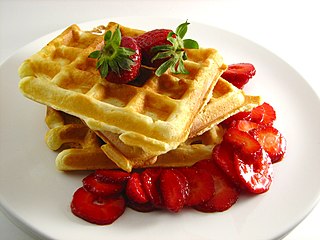
A waffle is a dish made from leavened batter or dough that is cooked between two plates that are patterned to give a characteristic size, shape, and surface impression. There are many variations based on the type of waffle iron and recipe used. Waffles are eaten throughout the world, particularly in Belgium, which has over a dozen regional varieties. Waffles may be made fresh or simply heated after having been commercially cooked and frozen.
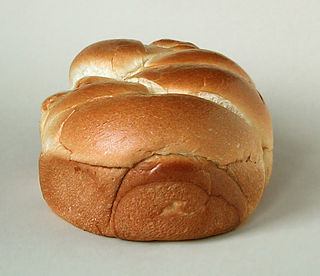
Brioche is a pastry of French origin whose high egg and butter content gives it a rich and tender crumb. The chef Joël Robuchon described it as "light and slightly puffy, more or less fine, according to the proportion of butter and eggs". It has a dark, golden, and flaky crust, frequently accentuated by an egg wash applied after proofing.

Shortbread or shortie is a traditional Scottish biscuit usually made from one part white sugar, two parts butter and three to four parts plain wheat flour. Shortbread does not contain any leavening, such as baking powder or baking soda. Shortbread is widely associated with Christmas and Hogmanay festivities in Scotland, and some Scottish brands are exported around the world.

A king cake, also known as a three kings cake, is a cake associated in many countries with Epiphany, the celebration of the Twelfth Night after Christmas. Its form and ingredients are variable, but in most cases a fève such as a figurine, often said to represent the Christ Child, is hidden inside. After the cake is cut, whoever gets the fève wins a prize. Modern fèves can be made of other materials, and can represent various objects and people.

Shortcake generally refers to a dessert with a crumbly scone-like texture. There are multiple variations of shortcake, most of which are served with fruit and cream. One of the most popular is strawberry shortcake, which is typically served with whipped cream. Other variations common in the UK are blackberry and clotted cream shortcake and lemon berry shortcake, which is served with lemon curd in place of cream.
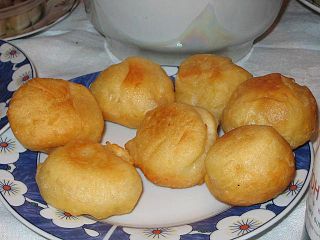
Pampúshka is a small savory or sweet yeast-raised bun or doughnut typical for Ukrainian cuisine.

Tsoureki also known as šurēk, čöreg, čʿorek, katʿnahuncʿ, çörək (Azerbaijani), çyrek (Albanian), kozunak, cozonac (Romanian) or paskalya çöreği (Turkish) is a sweet holiday bread made with flour, milk, butter, eggs, and sugar and commonly seasoned with orange zest, mastic resin, or mahlab. Lampropsomo, a variation of tsoureki commonly called "Greek Easter bread," is made by Greek communities during Easter, not only in Greece, but also in other countries with Greek communities. It is also called Armenian Easter bread and gets eaten during Easter in Armenia and the Armenian diaspora.

Cozonac or Kozunak is a sweet yeast dough that can be used to make different traditional holiday breads and cakes. Often mixed with raisins, it can be baked as a loaf or rolled out with fillings like poppy seed or walnuts. It is common throughout Southeastern Europe in countries such as Romania, Moldova, Bulgaria, Serbia, North Macedonia and Greece. Rich in eggs, milk and butter, it is usually prepared for Easter in Romania, Serbia, Bulgaria, and in Romania and Moldova it is also traditional for Good Friday, in a simplified version with vegan ingredients, without eggs or milk - named Cozonac de post - to be eaten by Christians during lent. The name comes from the Bulgarian word for hair-коса/kosa, or Greek: κοσωνάκι, romanized: kosōnáki, a diminutive form of κοσώνα, kosṓna.

Yomari, also called yamari, is a delicacy of the Newar community in Nepal. It is a steamed dumpling that consists of an external covering of rice flour with sweet fillings such as chaku and khuwa. The delicacy plays a very important role in Newa society, and is a key part of the festival of Yomari Punhi. According to some, the triangular shape of the Yamari is a symbolic representation of one half of the Shadkona, the symbol of Saraswati and wisdom.

Puto is a Filipino steamed rice cake, traditionally made from slightly fermented rice dough (galapong). It is eaten as is or as an accompaniment to a number of savoury dishes. Puto is also an umbrella term for various kinds of indigenous steamed cakes, including those made without rice. It is a sub-type of kakanin.

Knafeh is a traditional Arabic dessert, made with spun pastry called kataifi, soaked in a sweet, sugar-based syrup called attar, and typically layered with cheese, or with other ingredients such as clotted cream, pistachio or nuts, depending on the region. It is popular in the Middle East.

Baklava is a layered pastry dessert made of filo pastry, filled with chopped nuts, and sweetened with syrup or honey. It was one of the most popular sweet pastries of Ottoman cuisine. It is also enjoyed in Arabian, Persian and Greek cuisine.

Bolo de rolo is a typical Brazilian dessert, from the state of Pernambuco. The cake batter is made with flour, eggs, butter and sugar. This dough is wrapped with a layer of guava paste, giving the appearance of a swiss roll with much thinner layers. It is recognized as a national dish in Brazilian law.
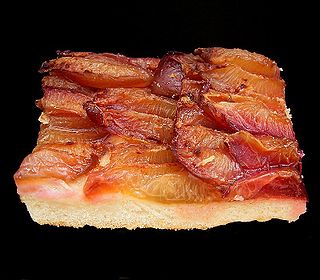
Zwetschgenkuchen, Pflaumenkuchen, Zwetschgendatschi or Zwetschgenplootz (Franconia) is a sheet cake made from yeast dough, shortcrust dough, or cake batter that is thinly spread onto a baking sheet and covered with pitted zwetschgen plums before being baked.

Khanom krok or coconut-rice pancakes or mortar toasted pastry, is a traditional Thai dessert. They are prepared by mixing rice flour, sugar, and coconut milk to form a dough. Usually, khanom krok is composed of two batters, one salty and one sweet, both of which are cooked in a heating mantle—a hot indented frying pan. After heating, khanom krok is picked out of the mantle and the two half-circular doughs formed into a circular shape.
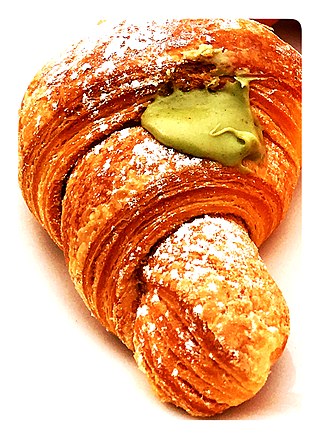
A cornetto is historically the Italian name of a product similar to the Austrian kipferl, although today it is an interchangeable name for the French croissant.
Easter cakes (breads) are cakes prepared and served during the Easter season. Sharing a cake with family for Easter is an Easter tradition in many denominations and countries.
References
- ↑ French, Headstart for Belgium: Cultural Notes. Defense Language Institute, Foreign Language Center. 1984. p. 24.
- ↑ Davidson, Alan (2014-08-21). The Oxford Companion to Food. OUP Oxford. p. 77. ISBN 978-0-19-104072-6.
- ↑ Roufs, Timothy G.; Roufs, Kathleen Smyth (2014-07-29). Sweet Treats around the World: An Encyclopedia of Food and Culture: An Encyclopedia of Food and Culture. ABC-CLIO. p. 41. ISBN 978-1-61069-221-2.